Related Research Articles

A propeller is a device with a rotating hub and radiating blades that are set at a pitch to form a helical spiral which, when rotated, exerts linear thrust upon a working fluid such as water or air. Propellers are used to pump fluid through a pipe or duct, or to create thrust to propel a boat through water or an aircraft through air. The blades are shaped so that their rotational motion through the fluid causes a pressure difference between the two surfaces of the blade by Bernoulli's principle which exerts force on the fluid. Most marine propellers are screw propellers with helical blades rotating on a propeller shaft with an approximately horizontal axis.

A wing is a type of fin that produces lift while moving through air or some other fluid. Accordingly, wings have streamlined cross-sections that are subject to aerodynamic forces and act as airfoils. A wing's aerodynamic efficiency is expressed as its lift-to-drag ratio. The lift a wing generates at a given speed and angle of attack can be one to two orders of magnitude greater than the total drag on the wing. A high lift-to-drag ratio requires a significantly smaller thrust to propel the wings through the air at sufficient lift.

A rudder is a primary control surface used to steer a ship, boat, submarine, hovercraft, aircraft, or other vehicle that moves through a fluid medium. On an aircraft the rudder is used primarily to counter adverse yaw and p-factor and is not the primary control used to turn the airplane. A rudder operates by redirecting the fluid past the hull or fuselage, thus imparting a turning or yawing motion to the craft. In basic form, a rudder is a flat plane or sheet of material attached with hinges to the craft's stern, tail, or after end. Often rudders are shaped so as to minimize hydrodynamic or aerodynamic drag. On simple watercraft, a tiller—essentially, a stick or pole acting as a lever arm—may be attached to the top of the rudder to allow it to be turned by a helmsman. In larger vessels, cables, pushrods, or hydraulics may be used to link rudders to steering wheels. In typical aircraft, the rudder is operated by pedals via mechanical linkages or hydraulics.
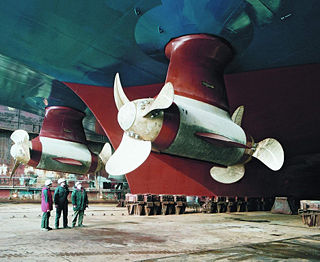
An azimuth thruster is a configuration of marine propellers placed in pods that can be rotated to any horizontal angle (azimuth), making a rudder redundant. These give ships better maneuverability than a fixed propeller and rudder system.

The Voith Schneider Propeller (VSP) is a specialized marine propulsion system (MPS) manufactured by the Voith Group based on a cyclorotor design. It is highly maneuverable, being able to change the direction of its thrust almost instantaneously. It is widely used on tugs and ferries.

A Z-drive is a type of marine propulsion unit. Specifically, it is an azimuth thruster. The pod can rotate 360 degrees allowing for rapid changes in thrust direction and thus vessel direction. This eliminates the need for a conventional rudder.
Aircraft flight mechanics are relevant to fixed wing and rotary wing (helicopters) aircraft. An aeroplane, is defined in ICAO Document 9110 as, "a power-driven heavier than air aircraft, deriving its lift chiefly from aerodynamic reactions on surface which remain fixed under given conditions of flight".
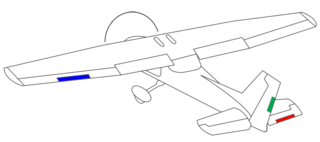
Trim tabs are small surfaces connected to the trailing edge of a larger control surface on a boat or aircraft, used to control the trim of the controls, i.e. to counteract hydro- or aerodynamic forces and stabilise the boat or aircraft in a particular desired attitude without the need for the operator to constantly apply a control force. This is done by adjusting the angle of the tab relative to the larger surface.
This is an alphabetical list of articles pertaining specifically to aerospace engineering. For a broad overview of engineering, see List of engineering topics. For biographies, see List of engineers.

The Kitchen rudder is the familiar name for "Kitchen's Patent Reversing Rudders", a combination rudder and directional propulsion delivery system for relatively slow speed displacement boats which was invented in the early 20th century by John G. A. Kitchen of Lancashire, England. It turns the rudder into a directional thruster, and allows the engine to maintain constant revolutions and direction of drive shaft rotation while altering thrust by use of a control which directs thrust forward or aft. Only the rudder pivots; the propeller itself is on a fixed shaft and does not.
The turbosail or French turbovoile is a marine propulsion system using a sail-like vertical surface and a powered boundary layer control system to improve lift across a wide angle of attack. This allows the sail to power the boat in any direction simply by moving a single flap at the back of the sail, unlike conventional sails which have to be continually adjusted to react to changes in the relative wind.
Self-steering gear is equipment used on sail boats to maintain a chosen course or point of sail without constant human action.
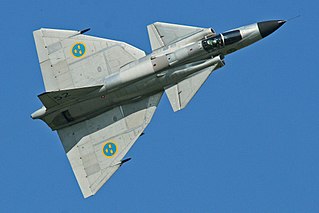
In aeronautics, a canard is a wing configuration in which a small forewing or foreplane is placed forward of the main wing of a fixed-wing aircraft or a weapon. The term "canard" may be used to describe the aircraft itself, the wing configuration, or the foreplane. Canard wings are also extensively used in guided missiles and smart bombs.

A Schilling rudder is a specific type of profiled rudder used on certain boats and ships.
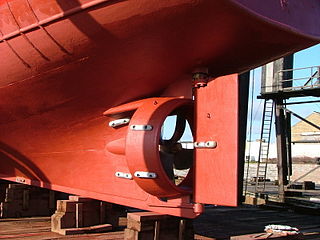
A ducted propeller, also known as a Kort nozzle, is a marine propeller fitted with a non-rotating nozzle. It is used to improve the efficiency of the propeller and is especially used on heavily loaded propellers or propellers with limited diameter. It was developed first by Luigi Stipa (1931) and later by Ludwig Kort (1934). The Kort nozzle is a shrouded propeller assembly for marine propulsion. The cross-section of the shroud has the form of a foil, and the shroud can offer hydrodynamic advantages over bare propellers, under certain conditions.

MS Côtes des Dunes is a Rodin-class ropax ferry operated by DFDS Seaways and currently in service between Dover and Calais.

The Zeppelin-Lindau Rs.II was a biplane flying boat, designed by Claudius Dornier as a follow-on to his Zeppelin-Lindau Rs.I and built during 1914–1915 on the German side of Lake Constance. Initially this aircraft was powered by three engines mounted inside the hull driving three pusher propellers via gearboxes and shafts. The later version was powered by four engines in two push-pull nacelles mounted between the wings.
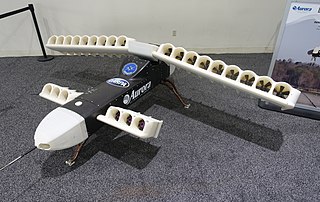
In aeronautics, Distributed propulsion is an arrangement in which the propulsive and related air flows are distributed over the aerodynamic surfaces of an aircraft. The purpose is to improve the craft's aerodynamic, propulsive and/or structural efficiency over an equivalent conventional design.
Schottel is a manufacturer of propulsion and steering systems for ships and offshore applications. The company founder Josef Becker invented the rudderpropeller, a z-drive, in 1950. Today the company develops and manufactures azimuth propulsion, maneuvering and steering systems. In 2014 the subsidiary Schottel Hydro was founded to bundle up the company activities in the hydrokinetic energy segment.
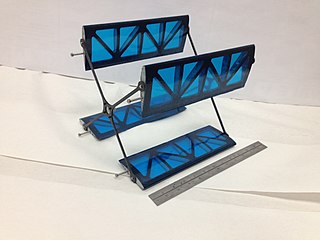
A cyclorotor, cycloidal rotor, cycloidal propeller or cyclogiro, is a fluid propulsion device that converts shaft power into the acceleration of a fluid using a rotating axis perpendicular to the direction of fluid motion. It uses several blades with a spanwise axis parallel to the axis of rotation and perpendicular to the direction of fluid motion. These blades are cyclically pitched twice per revolution to produce force in any direction normal to the axis of rotation. Cyclorotors are used for propulsion, lift, and control on air and water vehicles. An aircraft using cyclorotors as the primary source of lift, propulsion, and control is known as a cyclogyro or cyclocopter. A unique aspect is that it can change the magnitude and direction of thrust without the need of tilting any aircraft structures. The patented application, used on ships with particular actuation mechanisms both mechanical or hydraulic, is named after German company Voith Turbo.